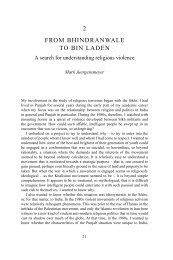New Glob Fu JFTR1275.pdf - Jan Nederveen Pieterse
New Glob Fu JFTR1275.pdf - Jan Nederveen Pieterse
New Glob Fu JFTR1275.pdf - Jan Nederveen Pieterse
Create successful ePaper yourself
Turn your PDF publications into a flip-book with our unique Google optimized e-Paper software.
Author's personal copy<br />
712<br />
ARTICLE IN PRESS<br />
J. <strong>Nederveen</strong> <strong>Pieterse</strong> / <strong>Fu</strong>tures 40 (2008) 707–720<br />
anti-Americanism affects the status of American products and American pop culture is no longer the edge of<br />
cool. An advertising executive notes growing resentment of American-led globalization.<br />
We know that in Group of 8 countries, 18 percent of the population claim they are avoiding American<br />
brands, with the top brand being Marlboro in terms of avoidance. Barbie is another one. McDonald’s is<br />
another. There is a cooling towards American culture generally across the globe. [25].<br />
Tipping points in relation to American hegemony are domestic—high interest rates, necessary to sustain<br />
external borrowing, put pressure on the inflated housing market and credit card debt. External tipping points<br />
are fading dollar loyalty, financial markets following new money, the debacles in Iraq and Afghanistan, and<br />
the general American legitimacy crisis.<br />
There are generally three different responses to American hegemony. (1) Continued support—for a variety<br />
of reasons such as the appeal of the US market, the role of the dollar, reliance on the American military<br />
umbrella, and lingering hope in the possibility of American self-correction. (2) Soft balancing—from tacit<br />
non-cooperation (such as most European countries staying out of the Iraq war and declining genetically<br />
modified food) to establishing alternative institutions (such as the Kyoto Protocol and the International<br />
Criminal Court). And (3) hard balancing—only few countries can afford this either because they have already<br />
been branded as enemies of the US, so they have nothing to lose (Iran, North Korea, Cuba, Venezuela) or<br />
because their bargaining power allows maneuvering room (China and SCO). China displays all three<br />
responses in different spheres—economic cooperation (WTO), non-cooperation in diplomacy (UN Security<br />
Council) and overt resistance in Central Asia [26] and in relation to Iran. An intriguing trend is that the<br />
number of countries that combine these different responses to US hegemony in different spheres is steadily<br />
increasing.<br />
American unilateralism and preventive war are gradually giving way to multipolarity if only because<br />
unilateralism has become too costly, militarily, politically and economically. <strong>New</strong> clusters and alignments are<br />
taking shape around trade, energy and security. The webs of interdependence (in technology, investments,<br />
finance, corporate tie-ups and markets) are far denser than they were during the previous epoch of hegemonic<br />
decline. Sprawling global realignments that crisscross economic and political zones point to the growing<br />
multipolarity rather than hegemonic rivalry.<br />
5. Inequality<br />
The flashpoints of global inequality are rural crises and urban poverty in NIEs, chronic poverty in the least<br />
developed countries, and international migration.<br />
Let us review this in a wider time frame. Postwar capitalism from the 1950s to the 1970s combined growth<br />
and equity; although overall North–South inequality widened, economic growth went together with the<br />
growing equality between and within countries. Neoliberalism during 1980–2000 brought a sharp trend break:<br />
now economic growth came with sharply increasing inequality within and between countries. The main<br />
exceptions to the trend were the East Asian tiger economies.<br />
The trend in the 2000s is that overall inequality between advanced economies and NIEs is narrowing while<br />
inequality in NIEs is increasing. The pattern of rising inequality in neoliberal economies (US, UK) continues<br />
and now extends to Japan, South Korea and Australia. International migration has become a major flashpoint<br />
of global inequality and produces growing conflicts and dilemmas around migration in many countries.<br />
Overall global inequality is staggering, with 1 percent of the world’s population now owning 40 percent of the<br />
world’s assets.<br />
According to James Rosenau’s upbeat assessment, rising human development indices, urbanization and<br />
growing social and communication densities are producing a general ‘skills revolution’ [27]. However, the<br />
flipside of the technological change and knowledge economies is that with rising skill levels also come widening<br />
skills differentials and urban–rural disparities. The second general cause of growing inequality is neoliberalism<br />
or unrestrained market forces, promoted by multinationals, international institutions and business media.<br />
Familiar short hands are Wal-Mart capitalism (low wages, low benefits, and temp workers), Las Vegas<br />
capitalism (speculative capital) and shareholder capitalism (in contrast to stakeholder capitalism). The third<br />
general cause of inequality, which affects developing countries, are policies that pursue fast growth and reflect<br />
middle class and urban bias and aggravate rich–poor and urban–rural gaps.





